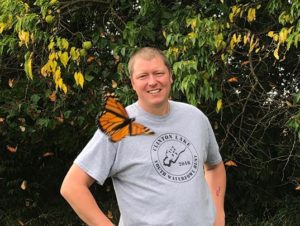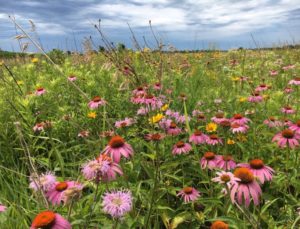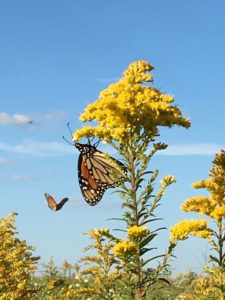
Jason Bleich’s family farm has been a popular resting spot for monarchs over the past couple of years. Photo courtesy of Jason Bleich.
By: Dana Rogge, USDA
A natural phenomenon descends on the Bleich’s Illinois farm each fall. Now through the end of September, Jason Bleich’s family farm will be invaded with thousands of monarch butterflies traveling south to their winter hideaway.
“It’s really amazing to be honest. It will give you goosebumps when you go out there and see them all,” Jason Bleich said. “When you walk along a hedge row or a windbreak where they’re all roosting in the trees and they start flying up as you walk by them and being able to hear their wings beating and have them land on you. It’s pretty neat.”
According to the U.S. Forest Service, the monarch is the only butterfly known to make a two-way migration as birds do. Monarchs use environmental clues to know when it’s time for their journey south is to begin.

A pollinator’s paradise, Jason and his family have implemented a variety of conservation practices on their 75-acre farm. Photo courtesy of Jason Bleich.
A Pollinator’s Respite
The Bleich’s farm has been a popular resting spot for monarchs over the past couple of years. A pollinator’s paradise, Jason and his family have implemented a variety of conservation practices on their 75-acre farm near Roberts, Illinois. In fact, their entire farm is enrolled in USDA Farm Service Agency’s (FSA) Conservation Reserve Program (CRP).
CRP is a land conservation program in which enrolled farmers remove environmentally sensitive land from agricultural production and plant species that will improve environmental health and quality. In exchange for implementing these practices, participants receive annual rental payments. CRP helps to re-establish valuable land cover to improve water quality, prevent soil erosion, and reduce loss of wildlife habitat.
Jason and his family have added windbreaks to their farm by planting evergreens, hardwood trees, and shrubs. They also planted native grasses and wildflowers around field borders. Additionally, they’ve added pollinator habitat and restored wetlands back on the farm. Jason attributes the large numbers of monarchs visiting his farm to CRP, the diversity of the seed mixes they use, and the proximity of his farm to other CRP acres close by.

The Bleich’s farm has been a popular resting spot for monarchs over the past couple of years. Photo courtesy of Jason Bleich.
Added Benefits
In addition to pollinators, Jason has seen an increase in other wildlife including pheasants, ducks, geese, and deer. Loving the outdoors and hunting, this is an added bonus for the Bleich family.
“The great thing is, the same habitat that’s great for monarchs is great for a ton of other wildlife species,” he said.
Jason, a Conservation Specialist for Pheasants Forever, believes high-quality, diverse seed mixes for native habitat is crucial for pollinators.
“One out of every three bites of the food that we eat comes from pollinators,” he said. “With the monarch (population) declining in the last 20 years, it’s crucial that we start putting some better habitat back out there for them, otherwise it won’t be long before they’re gone.”
In addition to CRP, USDA offers other programs to help farmers and landowners attract pollinators. The Natural Resources Conservation Service (NRCS) offers technical and financial assistance to help landowners manage for monarch habitat on farms, ranches and forests.
More Information
USDA offers a variety of risk management, disaster assistance, loan, and conservation programs to help agricultural producers in the United States weather ups and downs in the market and recover from natural disasters as well as invest in improvements to their operations. Learn about additional programs.
For more information about USDA programs and services, contact your local USDA service center.





